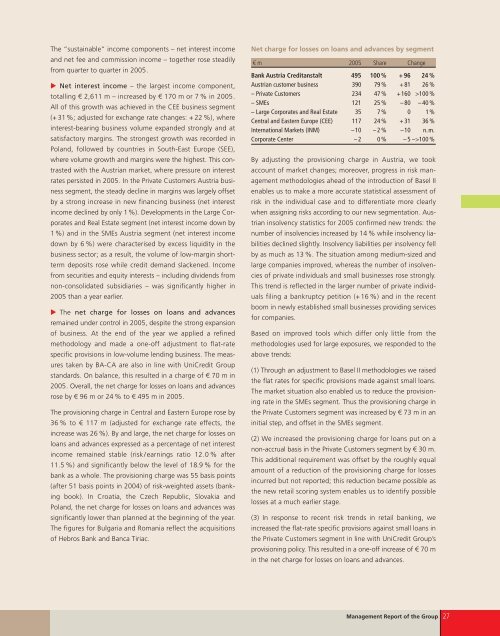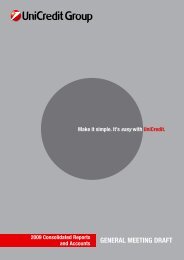team spirit - Bankier.pl
team spirit - Bankier.pl
team spirit - Bankier.pl
Create successful ePaper yourself
Turn your PDF publications into a flip-book with our unique Google optimized e-Paper software.
The “sustainable” income components – net interest income<br />
and net fee and commission income – together rose steadily<br />
from quarter to quarter in 2005.<br />
� Net interest income – the largest income component,<br />
totalling € 2,611 m – increased by € 170 m or 7 % in 2005.<br />
All of this growth was achieved in the CEE business segment<br />
(+ 31%; adjusted for exchange rate changes: + 22 %), where<br />
interest-bearing business volume expanded strongly and at<br />
satisfactory margins. The strongest growth was recorded in<br />
Poland, followed by countries in South-East Europe (SEE),<br />
where volume growth and margins were the highest. This contrasted<br />
with the Austrian market, where pressure on interest<br />
rates persisted in 2005. In the Private Customers Austria business<br />
segment, the steady decline in margins was largely offset<br />
by a strong increase in new financing business (net interest<br />
income declined by only 1%). Developments in the Large Corporates<br />
and Real Estate segment (net interest income down by<br />
1%) and in the SMEs Austria segment (net interest income<br />
down by 6 %) were characterised by excess liquidity in the<br />
business sector; as a result, the volume of low-margin shortterm<br />
deposits rose while credit demand slackened. Income<br />
from securities and equity interests – including dividends from<br />
non-consolidated subsidiaries – was significantly higher in<br />
2005 than a year earlier.<br />
� The net charge for losses on loans and advances<br />
remained under control in 2005, despite the strong expansion<br />
of business. At the end of the year we ap<strong>pl</strong>ied a refined<br />
methodology and made a one-off adjustment to flat-rate<br />
specific provisions in low-volume lending business. The measures<br />
taken by BA-CA are also in line with UniCredit Group<br />
standards. On balance, this resulted in a charge of € 70 m in<br />
2005. Overall, the net charge for losses on loans and advances<br />
rose by € 96 m or 24 % to € 495 m in 2005.<br />
The provisioning charge in Central and Eastern Europe rose by<br />
36 % to € 117 m (adjusted for exchange rate effects, the<br />
increase was 26 %). By and large, the net charge for losses on<br />
loans and advances expressed as a percentage of net interest<br />
income remained stable (risk/earnings ratio 12.0 % after<br />
11.5 %) and significantly below the level of 18.9 % for the<br />
bank as a whole. The provisioning charge was 55 basis points<br />
(after 51 basis points in 2004) of risk-weighted assets (banking<br />
book). In Croatia, the Czech Republic, Slovakia and<br />
Poland, the net charge for losses on loans and advances was<br />
significantly lower than <strong>pl</strong>anned at the beginning of the year.<br />
The figures for Bulgaria and Romania reflect the acquisitions<br />
of Hebros Bank and Banca Tiriac.<br />
Net charge for losses on loans and advances by segment<br />
€ m 2005 Share Change<br />
Bank Austria Creditanstalt 495 100 % + 96 24 %<br />
Austrian customer business 390 79 % + 81 26 %<br />
– Private Customers 234 47 % +160 >100 %<br />
– SMEs 121 25 % – 80 – 40 %<br />
– Large Corporates and Real Estate 35 7 % 0 1%<br />
Central and Eastern Europe (CEE) 117 24 % + 31 36 %<br />
International Markets (INM) –10 – 2 % –10 n.m.<br />
Corporate Center – 2 0 % – 5 –>100 %<br />
By adjusting the provisioning charge in Austria, we took<br />
account of market changes; moreover, progress in risk management<br />
methodologies ahead of the introduction of Basel II<br />
enables us to make a more accurate statistical assessment of<br />
risk in the individual case and to differentiate more clearly<br />
when assigning risks according to our new segmentation. Austrian<br />
insolvency statistics for 2005 confirmed new trends: the<br />
number of insolvencies increased by 14 % while insolvency liabilities<br />
declined slightly. Insolvency liabilities per insolvency fell<br />
by as much as 13 %. The situation among medium-sized and<br />
large companies improved, whereas the number of insolvencies<br />
of private individuals and small businesses rose strongly.<br />
This trend is reflected in the larger number of private individuals<br />
filing a bankruptcy petition (+16 %) and in the recent<br />
boom in newly established small businesses providing services<br />
for companies.<br />
Based on improved tools which differ only little from the<br />
methodologies used for large exposures, we responded to the<br />
above trends:<br />
(1) Through an adjustment to Basel II methodologies we raised<br />
the flat rates for specific provisions made against small loans.<br />
The market situation also enabled us to reduce the provisioning<br />
rate in the SMEs segment. Thus the provisioning charge in<br />
the Private Customers segment was increased by € 73 m in an<br />
initial step, and offset in the SMEs segment.<br />
(2) We increased the provisioning charge for loans put on a<br />
non-accrual basis in the Private Customers segment by € 30 m.<br />
This additional requirement was offset by the roughly equal<br />
amount of a reduction of the provisioning charge for losses<br />
incurred but not reported; this reduction became possible as<br />
the new retail scoring system enables us to identify possible<br />
losses at a much earlier stage.<br />
(3) In response to recent risk trends in retail banking, we<br />
increased the flat-rate specific provisions against small loans in<br />
the Private Customers segment in line with UniCredit Group’s<br />
provisioning policy. This resulted in a one-off increase of € 70 m<br />
in the net charge for losses on loans and advances.<br />
Management Report of the Group 27
















